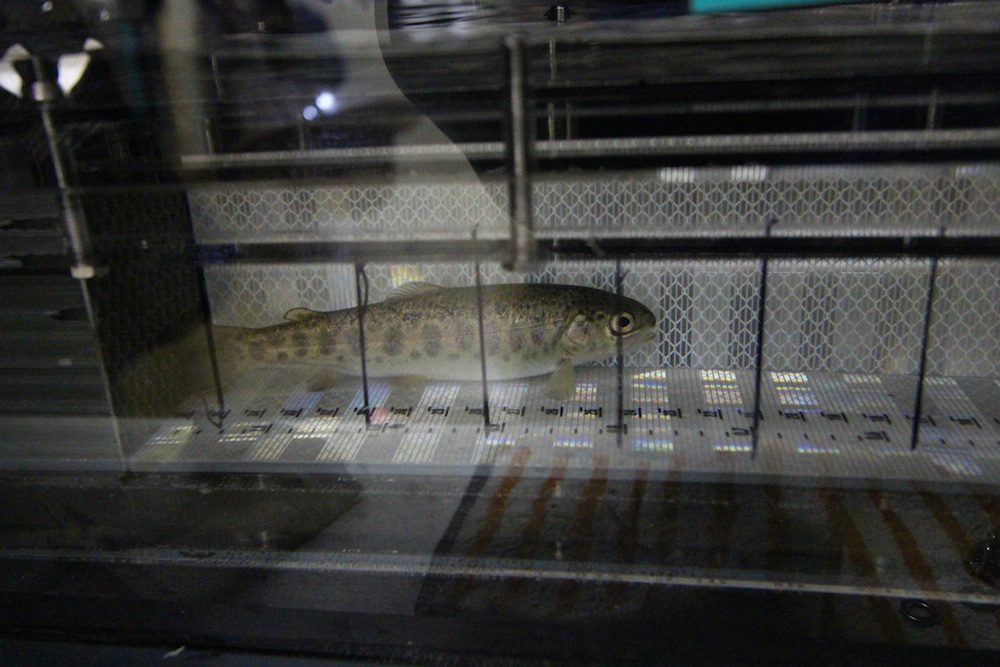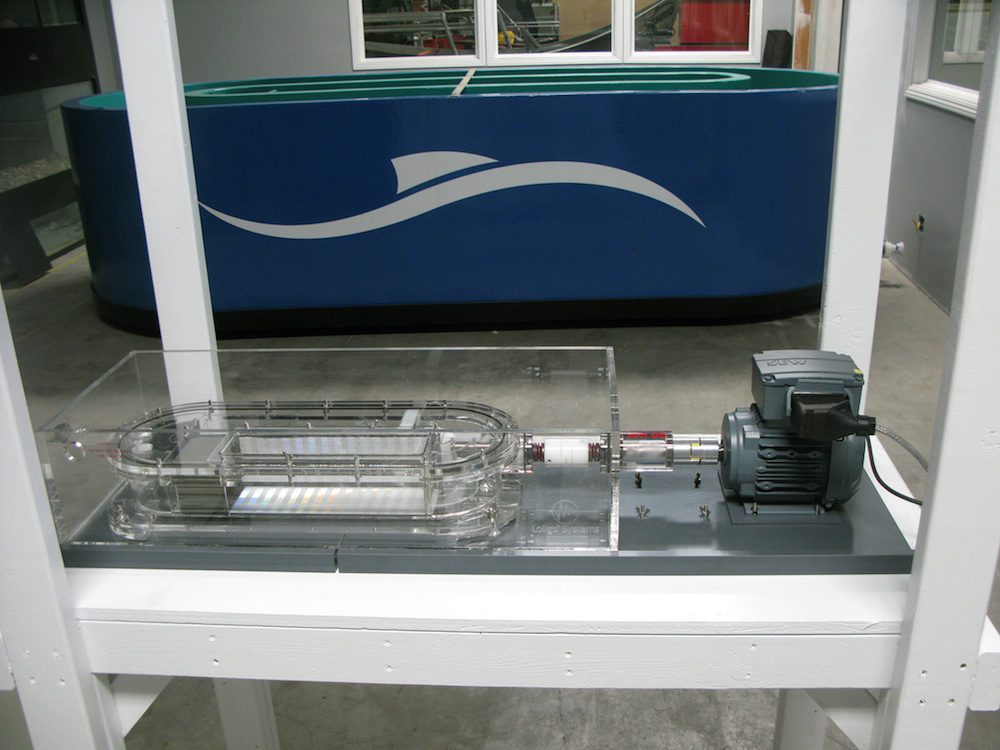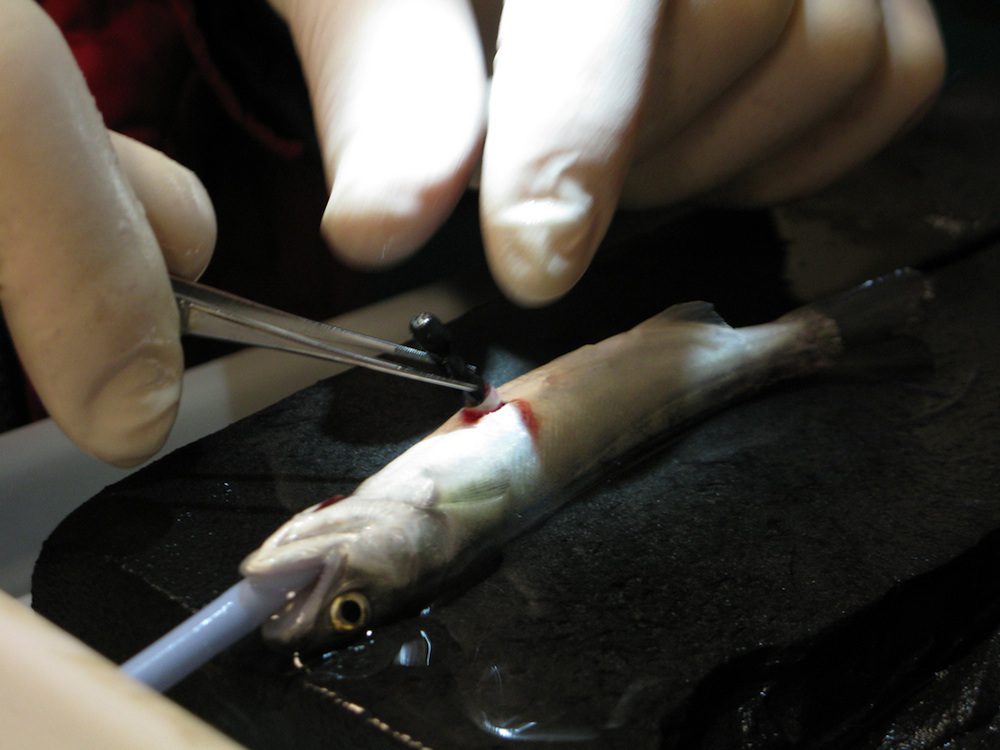Monday February 29, 2016
 Fish gotta swim – and just how long and fast they can do it is a major subject of scientific study. Fish scientists are increasingly studying respirometry, or fishes’ use of oxygen, in devices called swim tunnels, to learn about how a fish’s environment affects its ability to swim and perform other activities essential for survival. A swim tunnel is an underwater treadmill for fish that uses a motor to control water flow, and therefore the fish’s swimming speed. Swim tunnel respirometers also contain special oxygen monitoring equipment to measure the metabolic rate of fish in the swim tunnel.
Fish gotta swim – and just how long and fast they can do it is a major subject of scientific study. Fish scientists are increasingly studying respirometry, or fishes’ use of oxygen, in devices called swim tunnels, to learn about how a fish’s environment affects its ability to swim and perform other activities essential for survival. A swim tunnel is an underwater treadmill for fish that uses a motor to control water flow, and therefore the fish’s swimming speed. Swim tunnel respirometers also contain special oxygen monitoring equipment to measure the metabolic rate of fish in the swim tunnel.
In studies of fish swimming ability, swimming speeds are classified as sustained, prolonged, and burst (Hammer 1995). Sustained swimming is usually slow, but a fish can maintain this speed for very long periods of time, like running a marathon. Salmon performing the long migrations between their natal rivers and ocean feeding grounds usually swim at sustained speeds. You can imagine that it would be extremely time-consuming to measure how long fish can endure swimming at these sustained speeds in a swim tunnel, so this kind of measurement is usually assessed through other techniques, like tracking fish with acoustic telemetry tags in the field.
 Burst swimming is like sprinting: it is very fast, but can only be maintained for a short period of time (15 to 20 seconds). Fish with higher burst swimming endurance are more likely to successfully escape a predator attack, capture prey, or pass river rapids (Handelsman et al. 2010; Kieffer 2000). In order to assess burst swimming ability in a swim tunnel, scientists determine the maximum speed at which a fish can swim for 15 to 20 seconds. Scientists from British Columbia, Canada, used such tests to show that an environmental toxin (estrogen hormones) in the water affected maximum burst swimming speeds of rainbow trout, and thus may impair some rainbow trout activities, such as escaping predators or capturing prey, that are essential to survival (Osachoff et al. 2014).
Burst swimming is like sprinting: it is very fast, but can only be maintained for a short period of time (15 to 20 seconds). Fish with higher burst swimming endurance are more likely to successfully escape a predator attack, capture prey, or pass river rapids (Handelsman et al. 2010; Kieffer 2000). In order to assess burst swimming ability in a swim tunnel, scientists determine the maximum speed at which a fish can swim for 15 to 20 seconds. Scientists from British Columbia, Canada, used such tests to show that an environmental toxin (estrogen hormones) in the water affected maximum burst swimming speeds of rainbow trout, and thus may impair some rainbow trout activities, such as escaping predators or capturing prey, that are essential to survival (Osachoff et al. 2014).
Prolonged swimming falls between sustained and burst swimming in speed, and can be maintained for a relatively long time period (scientists define it as up to 200 min). Although prolonged swimming speeds are rarely utilized by fish in nature, they are probably the most common swimming type measured in the laboratory. This is because prolonged swimming tests tell scientists about more than just swimming ability; they also reveal information about the fish’s ability to continuously perform any energetically demanding activity. The standard test of prolonged swimming capacity is the ‘critical swimming velocity’ test, which involves gradually increasing the swim tunnel’s water velocity in steps. The fish swims for about 20 minutes at each swimming velocity step, until it becomes exhausted, and can no longer swim against the current. The critical swimming velocity is the highest water velocity the fish can continuously swim at for about 20 minutes. This maximum extent of prolonged swimming measures the fish’s swimming capacity, and also how well it can tolerate other stressors.
 For example, scientists from the U.S. Geological Survey used critical swimming velocity tests to study the effects of radio telemetry tag implants (which are used to track behavior and movements of free swimming fish) on juvenile Chinook salmon swimming ability (Adams et al. 1998). They found that attaching the tags externally to the fish’s body decreased its critical swimming speeds; however tags surgically implanted into the belly of the salmon did not have this effect. Additionally, salmon needed to recover from tag implant surgery for more than 24 hours before they could regain their normal swimming ability.
For example, scientists from the U.S. Geological Survey used critical swimming velocity tests to study the effects of radio telemetry tag implants (which are used to track behavior and movements of free swimming fish) on juvenile Chinook salmon swimming ability (Adams et al. 1998). They found that attaching the tags externally to the fish’s body decreased its critical swimming speeds; however tags surgically implanted into the belly of the salmon did not have this effect. Additionally, salmon needed to recover from tag implant surgery for more than 24 hours before they could regain their normal swimming ability.
Thanks to the special oxygen monitoring equipment in a swim tunnel respirometer, scientists can also use swim tunnels to measure the metabolic rate of fish at different swimming intensities. Scientists often use metabolic rate measurements on resting fish to learn about effects of the environment on fish survival (see metabolism fish report). In a swim tunnel respirometer, scientists can also track the increase in a fish’s metabolic rate as they ratchet up the water velocity to increase the fish’s swimming speed, usually during 20-minute increments. These measurements can be used to determine the maximum metabolic rate that a fish can achieve.
FISHBIO scientists used a swim tunnel respirometer to test the effects of temperature on the metabolism of resting and swimming rainbow trout, and thus determine the best river temperatures for their survival (see swim tunnel study blog). Such measurements from swim tunnel studies also provide a reference for studies like our work to measure fish tail beat frequency in rivers. Clearly, there is much valuable information to be gained by putting fish through their paces on a swimming treadmill.
This post featured in our weekly e-newsletter, the Fish Report. You can subscribe to the Fish Report here.
